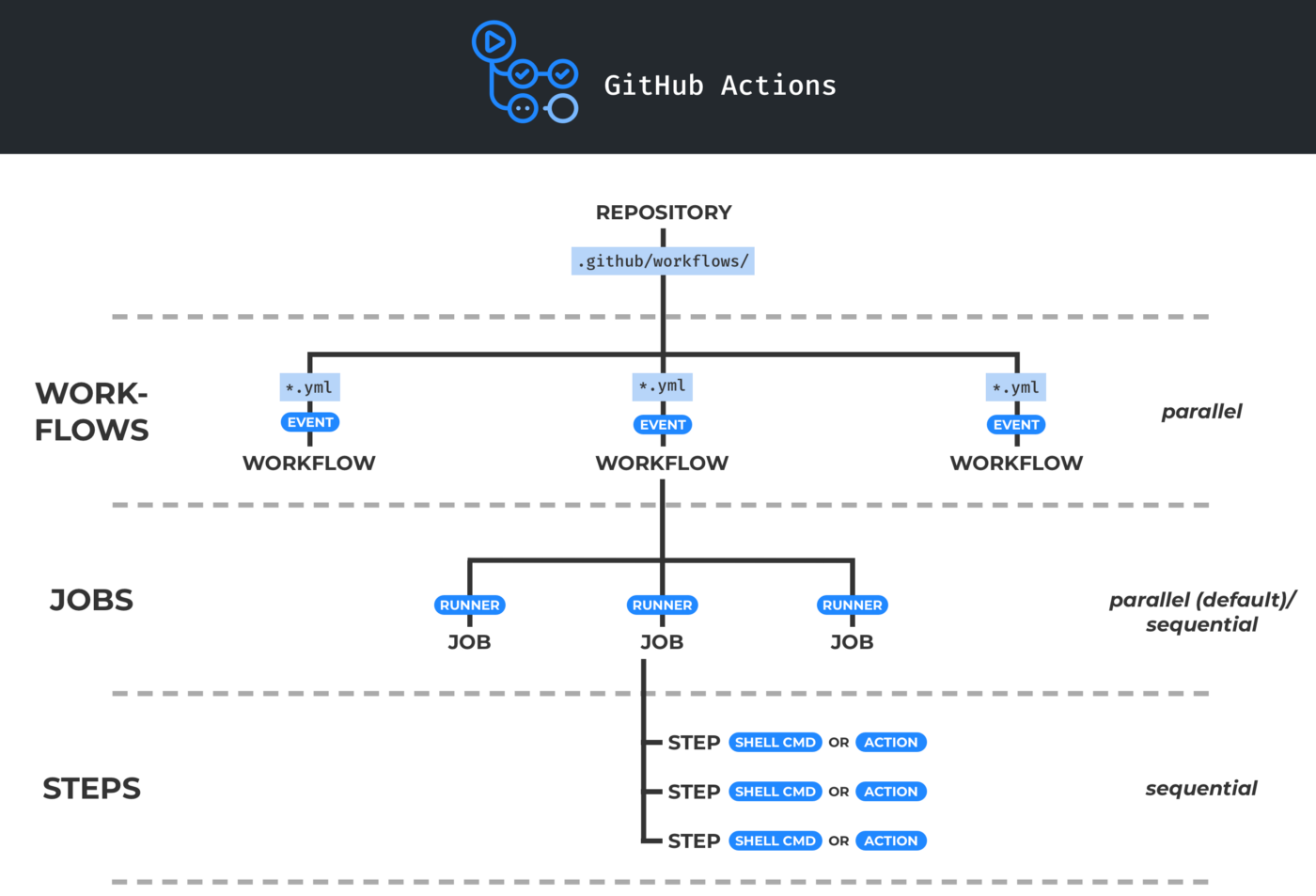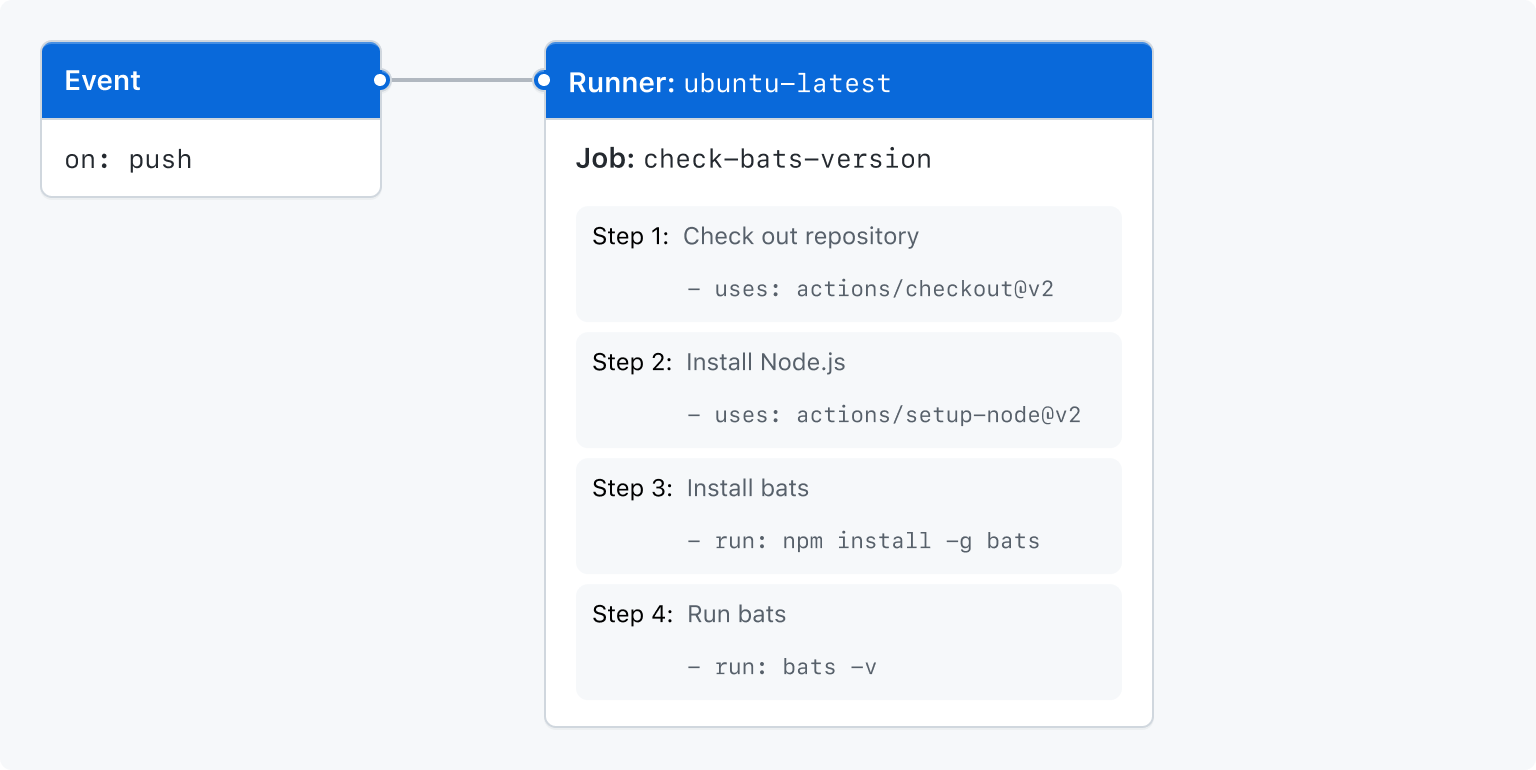Getting Started
What is GitHub Actions?
GitHub Actions is a continuous integration and continuous delivery (CI/CD) platform that allows you to automate your build, test, and deployment pipeline. You can create workflows that build and test every pull request to your repository, or deploy merged pull requests to production.
GitHub Actions use yaml files to define event, jobs, and steps.
These yaml files are stored in .github/workflows directory.
An event automatically triggers the workflow, which contains a job. The job then uses the steps to control the order, in which the actions are run. These actions are the commands that automate the software testing.
GitHub Actions Components

You can configure a GitHub Actions workflow to be triggered when an event occurs in your repository, such as a pull request being opened or an issue being created. Your workflow contains one or more jobs which can run in sequential order or in parallel. Each job will run inside its own virtual machine runner, or inside a container, and has one or more steps that either run a script that you define or run an action, which is a reusable extension that can simplify your workflow.
Workflow
A workflow is a configurable automated process that will run one or more jobs.
- Defined by YAML files in the
.github/workflowsdirectory in a repository. A repository can have multiple workflows, each of which can perform a different set of tasks. - Runs when triggered by an event in your repository, or they can be triggered manually, or at a defined schedule.
- You can reference a workflow within another workflow, see “Reusing workflows.”
(For more information about workflows, see “Using workflows.”)
Events
An event is a specific activity in a repository that triggers a workflow run.
- For example, activity can originate from GitHub when someone creates a pull request, opens an issue, or pushes a commit to a repository.
For a complete list of events that can be used to trigger workflows, see Events that trigger workflows.
Jobs
A job is a set of steps in a workflow that execute on the same runner.
- Each step is either a shell script that will be executed, or an action that will be run.
- Steps are executed in order and are dependent on each other.
- Each step is executed on the same runner. (you can share data from one step to another. )
By default, jobs have no dependencies and run in parallel with each other.
When a job takes a dependency on another job, it will wait for the dependent job to complete before it can run.
Actions
An action is a custom application for the GitHub Actions platform that performs a complex but frequently repeated task.
Use an action to help reduce the amount of repetitive code that you write in your workflow files.
You can write your own actions (see “Creating actions”), or you can find actions to use in your workflows in the GitHub Marketplace.
Runners
A runner is a server that runs your workflows when they’re triggered.
- A runner is a server that runs your workflows when they’re triggered.
- GitHub provides Ubuntu Linux, Microsoft Windows, and macOS runners to run your workflows. Each workflow run executes in a fresh, newly-provisioned virtual machine.
Understanding the Workflow File
Let’s say we have created a learn-github-actions.yml in the .github/workflows/ directory in the repository:
# Optional
# The name of the workflow
# as it will appear in the "Actions" tab of the GitHub repository.
name: learn-github-actions
# Optional
# The name for workflow runs generated from the workflow,
# which will appear in the list of workflow runs on your repository's "Actions" tab.
run-name: ${{ github.actor }} is learning GitHub Actions
# Trigger for this workflow.
# Here we use the `push` event, so a workflow run is triggered every time
# someone pushes a change to the repository or merges a pull request.
on: [push]
jobs: # Group together all the jobs that run in this workflow
check-bats-version: # Define a job named `check-bats-version`
runs-on: ubuntu-latest # specify the runner on which this job runs
steps: # Group together all the steps that run in this job
# The `uses` keyword specifies that this step will run `v3` of the `actions/checkout` action.
# This is an action that checks out your repository onto the runner,`
# allowing you to run scripts or other actions against your code.
# You should use the checkout action any time your workflow will run against the repository's code.
- uses: actions/checkout@v3
- uses: actions/setup-node@v3
with:
node-version: '14'
# The `run` keyword tells the job to execute a command on the runner.
- run: npm install -g bats
- run: bats -v
Visualize the workflow we created in a hierarchy:

As we can see, each step executes a single action or shell script. Steps 1 and 2 run actions, while steps 3 and 4 run shell scripts.
View the Activity for a Workflow Run
When your workflow is triggered, a workflow run is created that executes the workflow. After a workflow run has started, you can see a visualization graph of the run’s progress and view each step’s activity on GitHub.
A step by step guide see: Viewing the activity for a workflow run
Quick Start Demo
See Quickstart for GitHub Actions